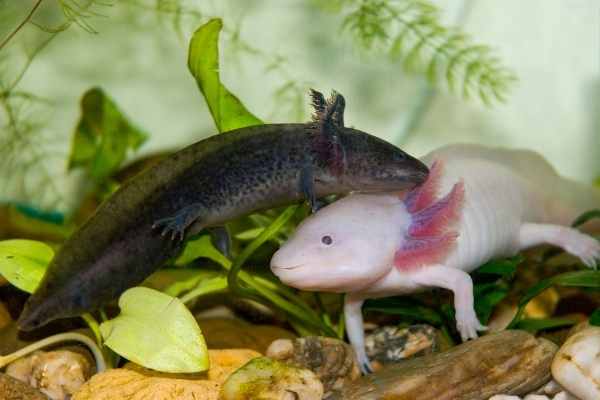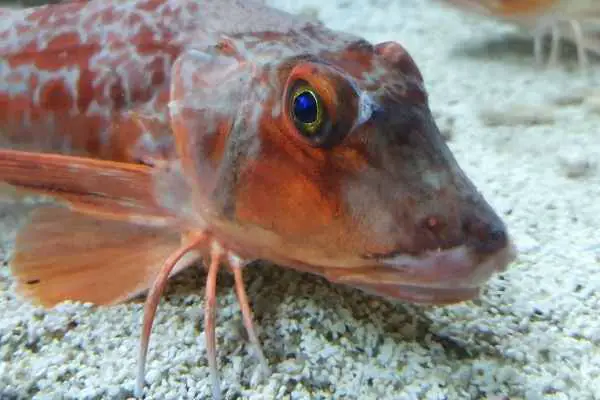Fish with legs. Each and every month, there are a bunch of people searching for this online. Are you one of them?
I consider myself to be a bit of a fish expert, so let me do my best to cover the topic.
Definition of a fish…do they have legs?
According to the Merriam-Webster dictionary, a fish with legs wouldn’t actually meet the definition of a fish. Take a look:
Definition:
Any of numerous cold-blooded strictly aquatic craniate vertebrates that …have typically an elongated somewhat spindle-shaped body terminating in a broad caudal fin, limbs in the form of fins when present at all, and a 2-chambered heart by which blood is sent through thoracic gills to be oxygenated
Source: https://www.merriam-webster.com/dictionary/fish
Not surprising then, a fish with legs wouldn’t likely be considered a fish. However, that doesn’t shut down this topic altogether, there are still a few interesting angles to consider.

Fish with legs: Evolutionary Biology
More than one scientist has theorized that the modern land-dwelling and therefore walking vertebrates evolved from fish, millions of years ago. The theory suggests that fish fins evolved into the legs that we all use to get around.
Modern theory suggests certain fish became the ancestors of modern-day four-legged creatures more than 360 million years ago.
One fascinating element of the evolutionary theories is that the evolution of eyes and eyesight that would allow for location of prey on the land is thought to have been an important precursor to the development of legs among fish.
Sounds like our ancient ancestors may have been motivated by food to get out of the water to grab a bite to eat.
Fish with toes
Another paleontologic discovery was from a fish, or fishlike creature named Acanthostega. It had a fish tail and gills, but had fins with toes. This was a paddle or lobe-finned vertebrate, it didn’t have the bony leg like structures.
Looking at our Genes, we share 70% of our Genes with fish and we have legs
Another way to explore Evolutionary biology is to look at our DNA. According to a fish expert at Penn State University, humans share 70% of the same genes as the Zebrafish, one of the most genetically well-known of our fishy friends.
Source: https://www.psu.edu/news/research/story/zebrafish-help-researchers-study-human-genes/
Fish with legs: Association with the Mexican Walking Fish or Axolotl
Another potential topic you might be looking for is general information, care and availability for an extremely popular animal known as the Mexican Walking Fish. Take a look.

This animal clearly has gills, lives underwater and has legs. Combine that with the fact that it also is commonly called a Mexican Walking Fish, and now I completely understand why you might be searching for information about a fish with legs.
It is perhaps important to note that while this animal does have gills, a tail, and lives underwater, it is not actually a fish.
Genetically speaking, the Mexican Walking Fish is an amphibian and therefore more closely related to a frog (or salamander) than a fish.
In fact, all amphibians are born in the water and spend part of their lives living and breathing underwater like fish.
For more information about the Mexican Walking Fish, I recommend this resource here:
https://animals.sandiegozoo.org/animals/axolotl
If you have young kids, this is an even better resource, because Axolotl’s are all the rage in Minecraft right now. Here’s a quick tip, you can catch them and move them around using a bucket.
Tadpoles look like fish with legs at one stage in their development
Sometimes tadpoles can look like fish with legs. Tadpoles are a larval/developmental stage that frogs and toads undergo before becoming adults. When they first emerge from their eggs, the look like larval fish, but eventually they growl legs and crawl out of the pond/lake/creek.
Fish alive today that use fins or bony rays like legs
Another possibility is that you’re interested in several different fish who use their fins and appendages to support their body weight and crawl/walk.
Mudskippers
One of my favorite land-dwelling fish is the Mudskipper. These adorable fish look a bit like they should be one of Jim Henson’s Muppets. They are fish. They live in the water, but spend a lot of time ‘skipping’ about in the mud and along the roots.
But take a closer look at the pectoral fin shown here and tell me that doesn’t look like a leg to you?

Take a look at a ‘normal’ fish fin and this bony leg-like fish fin of the Mudskipper.
“Walking” Sea robins and similar fish with walking rays
There is another group of fish with “legs” called the Sea Robins, that belong to the same Order of fish (that’s a taxonomic classification) as the much better known Lionfish.
Sea Robins are bottom-feeding saltwater fish that have specially evolved support structures that extend from their pectoral fins that they use to walk along the bottom of the ocean to move around and/or find a meal.

While these Sea robins use these appendages for a similar function that we use our legs, technically they are fish with “walking rays”, not fish with legs.
Incidentally, the Sea robins are not the only fish that move about with walking rays, but they are the group I know best—due to their propensity to hang around the same areas as the popular saltwater angling fish like Fluke and Seabass.
Conclusions
If we take this topic literally, a fish probably can’t have leg, in the classic sense, but one of the most fascinating aspects of Mother Nature and Evolution is that life finds a way. The reality of the matter is that, if you are inclined to believe Evolutionary Theories, as opposed to Biblical Theories of the Origin of Human, Fish are our ancestors.

Their DNA is entwined among our DNA, and the legs that we stand on are derived from their fins. So, in a way, if we explore this topic very liberally and apply what we’ve learned quite loosely, when you look in a mirror, you’re looking at a Fish with legs. Certainly a fish out of water, but at least some 70% fish.
What to read next
If you liked this article you should check out the following:
- 20 Most Popular Saltwater Fish
- 7 Coolest Saltwater Fish
- 25 Best Beginner fish
- How to set up a saltwater aquarium
References
Malcolm A. MacIver et. al., “Massive increase in visual range preceded the origin of terrestrial vertebrates.” PNAS March 21, 2017 114 (12) E2375-E2384.
Marcello Ruta, Matthew A. Wills. Comparable disparity in the appendicular skeleton across the fish-tetrapod transition, and the morphological gap between fish and tetrapod postcrania. Palaeontology, 2016; 59 (2): 249 DOI: 10.1111/pala.12227


Leave a Reply